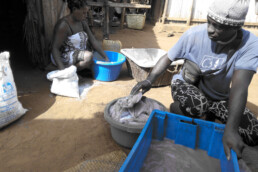Marine Protected Areas
Sustainable Marine Protected Area Management
Environmental management in the remote north.
In 2014 the Malagasy government committed to tripling the area of coast covered by Marine Protected Areas in Madagascar within 10 years. C3 works with the government’s Ministry of Environment, Madagascar National Parks and communities in order to realise this vision across the remote northern region of Madagascar from Nosy Be to Vohemar.
However, we are also concerned about long-term sustainability of marine protected area management. So many MPAs are merely ‘paper parks’ and no positive impacts are being delivered on the ground in terms of fisheries management, habitat replenishment and conservation and community engagement in monitoring and management. Madagascar is so vast and with poor physical and communication infrastructure that NGOs and government cannot possibly aspire to manage coastal areas. Local communities are at the forefront of managing their own coastal areas but sadly lack the capacity, infrastructure, and basic services to get engaged in such a task.
This is where NGOs like C3 are essential; spending time in the communities, getting to know people personally and helping build their own capacity to set up management infrastructure and lead their own monitoring and decision-making. This process takes years, there is no quick fix, but once a successful model is proven, with the injection of funds and personnel, it can be replicated across vast areas as proven in the case of Nosy Hara Marine Park.
Historically donors have invested heavily in the south west of Madagascar, being an extension of some of the first terrestrial-based foreign-led conservation interventions. However, the remote northern region is recognised by all international NGOs and the Malagasy government as the last frontier of coastal biodiversity and is yet still severely underfunded. C3 works in partnership with Conservation International at ‘orphan sites’ in key biodiversity areas; places where there has been no NGO interest historically due to their inaccessibility, yet which have been proven to be the key places to invest in, due to their natural propensity for climate change resilience.

A holistic stewardship model.
C3’s innovative and successful environmental stewardship model focuses on assessing the current functioning of MPAs in a holistic manner (traditional knowledge and tabus, governance, socio-economic and biodiversity assessments, financial sustainability) and then developing community capacity for governance and implementation of management plans.
C3’s programme is the only one to ensure delivery of key community services including diversified income generation, improvements in health (e.g WASH programme) and education services, is key to ensuring MPAs benefit local populations and reducing unsustainable practices.
Sustained, intensive outreach in the communities about fisheries regulations, climate change, species and habitats is a key focal area because only by fully understanding the purpose and objectives of MPAs can the community be fully motivated and mobilised to sustain them.
One of our key successes is reducing dependence of communities solely on fishing as a source of income. Building resilience to climate change is so essential in these communities who are at the forefront of environmental disturbances such as widescale coral bleaching, severe coastal erosion, and more frequent and devastating cyclones.
C3 has now established 10 community enterprises across 5 communities and recruited and trained 30 Conservation Ambassadors, who are volunteers in their communities in charge of training and educating others in sustainable development and environmental protection. Furthermore the immensely popular youth environmental leadership programme, the Junior Ecoguards, has a cohort of more than 1500 members across 70 schools in Sava, Diana, Boeny and Sofia regions. Junior Ecoguards educate their own communities about key conservation issues and assist with practical activities such as beach clean-ups, seagrass monitoring and mangrove reforestation.
C3 assisted with provision of new and improved water pumps and water storage facilities in drought-prone areas. In conjunction, a WASH programme ensured that people were aware about correct water conservation, handling and hygiene to help prevent water-borne diseases. We also work with USAID, GIZ, UNDP and Finistere to implement our sustainable development programme.
MPAs cannot be managed in isolation of terrestrial impacts, especially in C3 Madagascar is unique in applying the Ridge to Reef approach and works with communities upstream to replant riparian vegetation and native montane forests. We partner with Conservation International, Graine de Vie, Ministry of Fisheries, Ministry of Environment and Ministry of Agriculture. We also coordinate and advise the MIHARI network in terms of providing appropriate outreach materials on endangered marine species and habitats and assisting with human resource management support.

Related Case Studies
Contact
C3 MadagascarLot II PA 12 Bis, Soavinimerina, Ambohimanga Rova, Antananarivo, Avaradrano
C3 Madagascar (CONSERVATION CENTREE SUR LA COMMUNAUTE C3 MADAGASCAR), in accordance with Article No. 5 of Ordinance No. 60133, is registered as a non-profit organization in Madagascar under the Direction of the Territorial Administration of Antananarivo with Registration No. 1206/14-MID/SG/DGAT/DIRAT/ANT/ASS.



